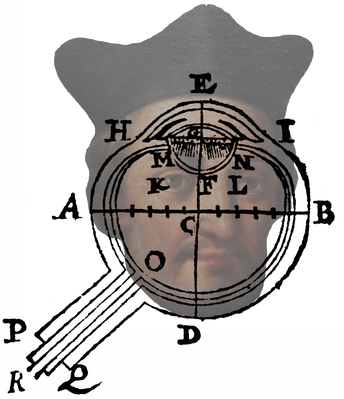Christoph Scheiner1573–1650
Kepler did not have available to him an adequate account of the anatomy of the eye. This was provided by a fellow astronomer, Christoph Scheiner, in 1619. Scheiner’s portrait is derived from a painting that hangs in the museum at Ingolstadt, where he was active in the Jesuit school. He is shown in the diagram of the mammalian eye published in his book: the lens and its curvatures are appropriately represented and the optic nerve leaves the eye nasally. This figure has frequently been reprinted, and it is often claimed that it represents a human eye, even though Scheiner stated that he did not have the opportunity of dissecting one: “The observation of most animals’ eyes tells us all these things; indeed these processes happen in the eyes of cows, sheep, goats, and pigs, on which I have done many experiments in the presence of other people; logical reasoning leads me to suppose a similar process for the human eyes as well, because in every man’s eye there is a hole, through which the optical nerve comes out, placed in the same position as in animals; indeed the cavities of each eye are placed in the skull along the sides of the bone which shapes the nasal projection, although in the case of man we have to rely on reasoning more than on observation, because I have never had the opportunity to test a human eye.” Thereafter, speculations about functions of the eye (like accommodation) could be guided by the operation of a camera, and artificial eyes could be constructed which followed similar laws of optics. For example in 1630, Scheiner illustrated corrections that could be applied to eyes and cameras for errors of refraction in his book which also described sunspots. He had earlier invented the pantograph, which enabled copies of drawings to be made at a different scale.
